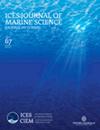Small pelagic fish in the shallow Wadden Sea show opportunistic feeding with a strong benthic link
IF 3.4
2区 农林科学
Q1 FISHERIES
引用次数: 0
Abstract
Small pelagic fish (SPF) are crucial in marine food webs, transferring energy from plankton to higher trophic levels. This study focuses on herring (Clupea harengus) and sprat (Sprattus sprattus), addressing knowledge gaps in their feeding ecology in a nursery area, the Dutch Wadden Sea. We conducted a year-long, monthly survey, and used DNA metabarcoding to analyse zooplankton samples and stomach contents of two size classes of herring and sprat. Intra-, interspecific, and seasonal variations in fish condition, stomach fullness, and diet composition, along with selective feeding, were studied. Our study showed that condition and diet composition of herring and sprat, along with zooplankton density, exhibited a clear seasonal pattern. Juvenile herring and sprat displayed opportunistic feeding behaviour, rather than showing distinct prey selection. Besides copepods, we regularly observed (larvae of) benthic invertebrates in their diet. This emphasizes the crucial role of SPF as energy transfer agents, not solely between trophic levels, but also from benthic to pelagic habitats. Furthermore, fish post-larvae were part of the diet of larger herring (10–15 cm). Because of its unprecedented temporal and taxonomical detail, this study advances the understanding of seasonal dynamics of dominant components at the base of the Wadden Sea food web.瓦登海浅海中的小型中上层鱼类表现出机会性觅食,与底栖生物联系紧密
小型中上层鱼类(SPF)在海洋食物网中至关重要,它们将浮游生物的能量转移到更高的营养级。本研究的重点是鲱鱼(Clupea harengus)和鲱鱼(Sprattus sprattus),以解决它们在荷兰瓦登海育苗区的摄食生态学方面的知识空白。我们进行了为期一年的月度调查,并使用 DNA 代谢编码分析了浮游动物样本和两种大小的鲱鱼和鲱鱼胃内容物。我们研究了鱼体内、鱼种间和季节性鱼体状态、胃的饱满度、食物组成以及选择性摄食的变化。我们的研究表明,鲱鱼和鲱鱼的体况和食物组成以及浮游动物密度呈现出明显的季节性规律。幼年鲱鱼和鲱鱼表现出机会性摄食行为,而不是明显的猎物选择。除了桡足类,我们还经常观察到底栖无脊椎动物的(幼虫)。这强调了 SPF 作为能量转移媒介的重要作用,不仅在营养级之间,而且从底栖到浮游栖息地也是如此。此外,鱼类后代也是较大鲱鱼(10-15 厘米)的食物之一。这项研究具有前所未有的时间和分类细节,有助于人们了解瓦登海食物网底部主要成分的季节动态。
本文章由计算机程序翻译,如有差异,请以英文原文为准。
求助全文
约1分钟内获得全文
求助全文
来源期刊

ICES Journal of Marine Science
农林科学-海洋学
CiteScore
6.60
自引率
12.10%
发文量
207
审稿时长
6-16 weeks
期刊介绍:
The ICES Journal of Marine Science publishes original articles, opinion essays (“Food for Thought”), visions for the future (“Quo Vadimus”), and critical reviews that contribute to our scientific understanding of marine systems and the impact of human activities on them. The Journal also serves as a foundation for scientific advice across the broad spectrum of management and conservation issues related to the marine environment. Oceanography (e.g. productivity-determining processes), marine habitats, living resources, and related topics constitute the key elements of papers considered for publication. This includes economic, social, and public administration studies to the extent that they are directly related to management of the seas and are of general interest to marine scientists. Integrated studies that bridge gaps between traditional disciplines are particularly welcome.
 求助内容:
求助内容: 应助结果提醒方式:
应助结果提醒方式:


